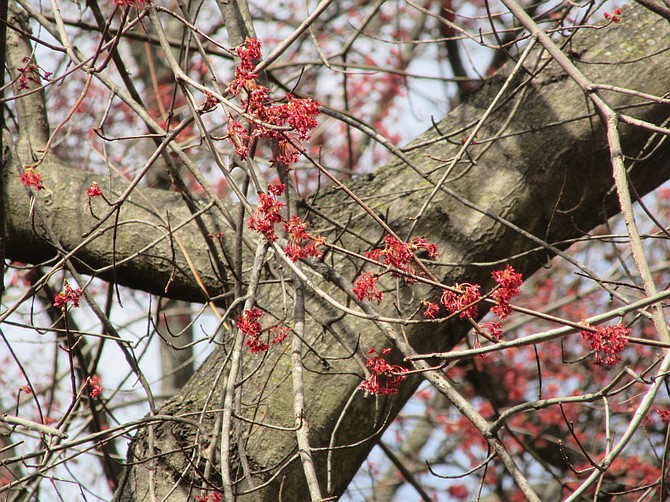Trees are not yet sporting their leafy glory, but there’s always much to learn about trees. On a blustery March 10 afternoon, Jim McGlone led a tree walk for 17 Friends of Dyke Marsh enthusiasts in the Dyke Marsh Wildlife Preserve. McGlone is a retired forester with the Virginia Department of Forestry.
Red maple flowers shimmered in the sun, sure signs of spring and one of the few bright colors visible on trees. Female American hollies were sporting red berries. Speaking of berries, McGlone said that berries of a typical invasive plant like bush honeysuckle have one to two percent fat content, but native plant berries, like viburnums, typically have 30 to 40 percent fat content. He believes that some bird populations may be declining because birds are “filling up on junk food” which impairs their ability to migrate.
Sweet gums, maples and oaks are common trees in Fairfax County, McGlone told the group. Sweet gums are easily identifiable by the brown “balls” that hang on the tree all winter. Finches feed on gumball seeds. He explained that black locust trees have prickles or briars, but the honey locust has thorns up to four inches long.
McGlone gave a tutorial on bark patterns. The black cherry tree has a scaly bark that looks like “burned potato chips,” he said. Green ash tree bark has a diamond pattern. The sycamore has exfoliating bark, a patchy look. As the tree ages, the bark turns white up the tree.
Smooth sumacs looked like nondescript, spindly saplings, but they will have white flowers “that are really good for pollinators,” he said. “They don’t look very interesting now,” he said, but their red berries “will be Christmas in July” and their leaves will turn flaming red in the fall. These trees will “grow in really crappy conditions,” like highway medians, he said.
McGlone also discussed invasive insects. Studying a non-native white mulberry tree, he explained that the spongy moth came to North America with this tree because it feeds on the tree. Here, the moth has no natural predators so unfortunately the moth “has been successful,” he noted.
Ditto the emerald ash borer, an insect from Asia that has spread across the United States. It attacks and can kill ash trees. In Dyke Marsh, National Park Service biologists have estimated that as many as 1,000 pumpkin ash trees could be affected by this insect. Since 2015, the Friends of Dyke Marsh have financed the treatment of 18 trees and so far, these trees are leafing out each spring.
Why save ash trees? They have many ecological values, but think the Louisville Slugger. Ash wood has long been a favorite wood for American baseball bats. “Practically every star hitter in baseball history – from Babe Ruth to Ted Williams to Jackie Robinson to Hank Aaron – stepped into the batter’s box with an ash bat,” reported InsideHook in 2022. But given the impact of the emerald ash borer, bat manufacturers have had to find alternatives.
Why Care about Trees -- A Few Reasons
* Trees’ shade can reduce a home or building’s cooling costs by 20-25 percent in the summer.
-- Fairfax County’s Urban Forest Management Division
* Mature trees can increase property values by 10 percent, on average. Landscaping with trees can increase property values up to 20 percent. -- Fairfax County’s Urban Forest Management Division
Trees can reduce anxiety and depression.
– The Nature Conservancy
* Forests absorb more carbon dioxide than they release and take carbon out of the atmosphere. Carbon dioxide is a major greenhouse gas pollutant that is warming the planet.
– National Geographic
* Trees reduce inland and coastal flooding. A single 10-inch-diameter red oak will intercept more than 1,200 gallons of stormwater per year in Virginia.
– Chesapeake Bay Foundation
* Forests absorb runoff. A one-inch rainfall on a one-acre parking lot sends 27,154 gallons of water into low-lying areas and streams. One inch of rain falling in a forest releases 750 gallons of runoff.
– Chesapeake Bay Foundation
More like this story
- Mount Vernon District Recognizes Residents for Character
- New Trail to Little Hunting Creek Is Coming
- Country Feeling Captured in a Painting at Nalls Produce
- The Dr. Larry Bussey Family & Community Library: FCSB approves renaming Family Resource Center library
- Local Students Among 40 Science Talent Finalists
